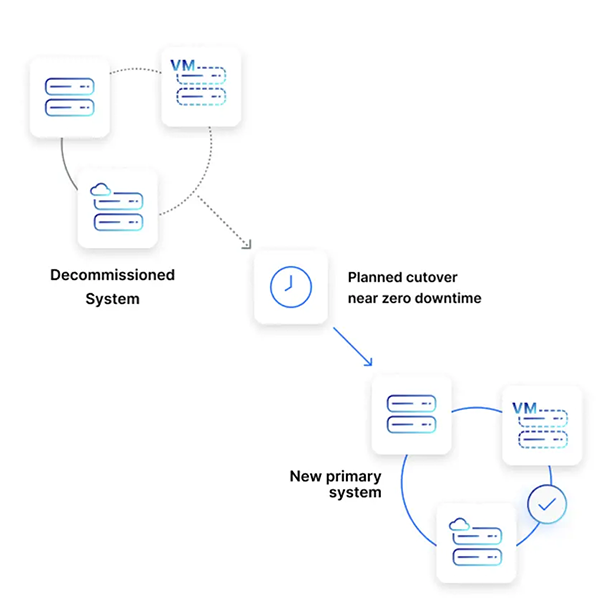
Carbonite™ Migrate
Migrate workloads--to and from any environment
Carbonite Migrate delivers an efficient, secure single solution to migrate your physical, virtual and cloud workloads - to and from any environment. And that’s with minimal risk and near-zero downtime for your business. With Carbonite Migrate, you can have simple, non-disruptive migrations and quick cutovers.
Let our Solutions Specialist help you Today!

Alleviate migration issues
Mergers and acquisitions, application and hardware upgrades, moving to the cloud and office or data-center relocations are just a few of the many reasons your organization needs to migrate data. The good news? Carbonite Migrate alleviates the many issues that often plague migration: data loss, allocation of IT resources, disrupted operations and compatibility issues. Avoid those issues, streamline migration and minimize downtime with Carbonite Migrate.
Benefits
With Carbonite Migrate you can:
Replicate data, files and system settings continuously and reliably to reduce downtime to minutes or seconds, and cutover quickly.
Prevent downtime while your data is being migrated.
Increase cost-efficiency by spending less on data storage.
Reduce the need for costly skilled resources and longer project duration thanks to automated cutover.
Perform unlimited testing of the new environment without disrupting operations.
Avoid locking in with any specific hypervisor, cloud vendor or hardware for more flexibility with your IT investment.
Why Carbonite Migrate?
Carbonite Migrate delivers a streamlined process. It automates and consolidates numerous steps, which are otherwise manual and prone to human error, into just a few simple tasks. Use Carbonite Migrate to reduce the amount of migration work you need to do.
Keep users and systems active and fully productive while your data is being migrated.
Eliminate vendor lock-in.
Eliminate risk with pre-flight checks, automation and non-disruptive testing.
Features
Comprehensive Carbonite Migrate delivers simplicity and repeatability through the following features:
Full-server or data-only migrations which are completely hardware and platform agnostic
Data and system migration to, from or between any combination of physical, virtual and cloud-based platforms, including public clouds like Amazon Web Services, Microsoft Azure and Google Cloud
Automated migration configuration and management with an easy-to-use console, eliminating common issues and streamlining migration
Continuous replication, at scale, with minimal impact to performance or bandwidth
Data protection in-flight with AES 256-bit encryption
Virtual-machine auto provisioning for Microsoft Hyper-V and VMware vSphere
Custom job configurations, automated workflows and orchestrated activities

How it works
Real-time, byte-level replication
Carbonite Migrate uses real-time, byte-level replication to duplicate your source system to the target. The replication maximizes bandwidth efficiency by sending small chunks of data, incorporating multiple levels of compression and enabling bandwidth throttling. Plus, AES 256-bit encryption keeps your data secure.
Easy and quick cutover
Cutover downtime is limited to seconds or minutes. If you need to revert to the original system, that execution is straightforward. What’s more, the cutover process is repeatable and predictable however you choose to manage it - through the unified console, automated scripting or third-party tools.
Non-disruptive testing
Test cutovers can be performed anytime without impacting production systems and business operations. End users can continue working on the source system until the final cutover.
Supported platforms
| Operating systems | Target environments |
| CentOS CloudLinux Debian Linux Microsoft Windows Server Oracle Enterprise Linux Red Hat Enterprise Linux Rocky Linux SUSE Enterprise Linux Ubuntu |
Amazon Web Services (AWS) Google Cloud Platform Microsoft Azure Resource Manager Microsoft Azure Stack Microsoft Hyper-V VMware vSphere VMware vCloud Director VMware ESXi |
